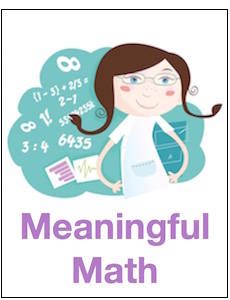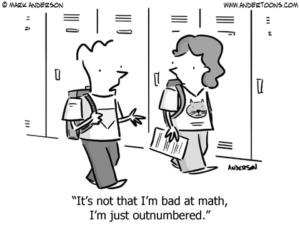My Students Struggle to Solve Basic Equations
A MiddleWeb Blog

I actually wrote an article about the problem in 2021: Refreshing Students’ Equation Solving Skills. Since then I have been purposefully trying to help students get better at solving equations.
I’ve done things like having students keep their work neater so they don’t make careless errors, drawing a line by the equal sign to help them visualize the equality, and in general just trying to get them to write things down.
Yet my students each year still continue to struggle in this area, and since solving an equation is the foundation that most higher math concepts build off of, we’ll continue to try to improve.
Pinpointing problem areas
I realized I was going to have to be more strategic if I was going to help my students. I needed to know what they are specifically having trouble understanding. So I picked two problems (they were based on 6th and 7th grade standards in our state) for my 11th graders to work.
MA19.6.19 Write and solve an equation in the form of x+p=q or px=q for cases in which p, q, and x are all non-negative rational numbers to solve real-world and mathematical problems.
MA19.7.9a Solve word problems leading to equations of the form px+q=r and p(x+q)=r, where p, q, and r are specific rational numbers. Solve equations of these forms fluently. Compare an algebraic solution to an arithmetic solution, identifying the sequence of the operations used in each approach.
I had my students come up to my desk one at a time. I presented them with the problems and a four-function calculator. They worked a problem and often talked out loud about what they were thinking as they were working. I didn’t ask them to, that was just a bonus!
Here are the two problems:
20 – 7x = 6x -6
And
2/3b + 7 = -1
I listened as they worked. Then I took the Post-it notes they had worked their problems on and really studied their work. In fact, I often rewrote what the student wrote so I could really understand their thinking. That helped me so much. I have always struggled trying to determine what students were thinking. By rewriting their work, I was able to gain more insight.
I then sorted the Post-it notes according to the type of error each student made. I have listed the categories below.
►Confused by Fractions

Some students stopped after subtracting both sides by 7 because they simply didn’t know what to do with 2/3, so their answer was -8. Some students multiplied both sides by two thirds instead of multiplying by the reciprocal; their answer was -16/3. One student subtracted 2/3 from both sides, after they subtracted 7 from both sides.
►Combined Unlike Terms
Students combined 20 with -7x to get 13x, while 6x-6 was combined to get x. And others combined 2/3b with 7 to get 14/3b.
►Moved or Lost the Equal Sign
If students subtracted so that they had a zero on one side of the equation, often the equal sign would just disappear. Sometimes the equal sign would never be seen in the students’ work at all.
What does this all mean?
In the broadest sense it means that students who struggle to solve a 6th or 7th grade level equation will definitely struggle to solve quadratic, exponential, or logarithmic equations that are part of the Algebra 2 course of study. More time has to be spent fortifying students’ ability in this area.
Realizing that this was necessary, we allowed for a few weeks at the beginning of the year to refresh students on solving equations. It wasn’t enough. Now I’m thinking it would be better to spiral in problems and continue working on it all year long.
Specifically, I think there are some fundamental skills related to solving equations that students are lacking. Maybe lacking is not the right word; maybe they have the skills but are unable to always apply them correctly or at the right time.
What are students not understanding?
I think the problem they have with fractions indicates they don’t understand reciprocals. Students know that 2/3 is literally 2 divided by 3; so they mistakenly think they should multiply both sides by 2/3. To complicate matters, they are afraid of fractions. They will skip a whole problem if it has a fraction in it.
Why are students still combining unlike terms? I am at a loss. We model constantly the correct way to combine like terms. I think sometimes, if students don’t know what to do, they think they should try anything. I heard a lot of “I know I’m supposed to do something here…”
The moving or missing equal sign is about more than sloppy work. It’s a lack of understanding about equivalence. They haven’t really learned what the equal sign signifies.
What to do about it?
These are my first thoughts about how to help students solve equations.
Model correct vocabulary, It’s not 7x; it’s 7 multiplied by x. It also might be helpful to say one x, as opposed to x. That’s tedious, but I don’t think all students understand the invisible “one” there. Also, do students know that multiplying by 3/2 will yield the same answer as dividing by 2/3?
Make sure students are clear on the definition of solving an equation. To solve an equation means to find all numbers that make the equation true. Source
Help students understand equivalence. Make it mandatory that students plug their solution back in after solving the problem. They will literally be able to see that the correct answer is one that makes the equation true. That will drive home the meaning of the equal sign and help them understand the definition of equivalence.
Be more intentional when teaching students how to “undo” multiplication, division, etc. Explicitly state when to subtract 2x from each side and when to divide both sides by 2.
I also need to diagnose problems sooner. I need to study students’ work in the early weeks of our time together and see what they know and what they don’t know about solving equations.
Final Thoughts
Much of the problem rests with my assumption that when students arrive in my class, they have mastered solving equations – when they haven’t. Going forward I am going to assume that my students need some coaching and practice and one-on-one help to be proficient at solving equations.
I can’t fall back on the fact that I work a lot of equations on the board. When students watch their teacher solve equations on the board, they don’t know what they don’t know. It’s easy to watch someone do something and think “that’s easy; I can do that.”
I plan to talk with other teachers in my department and see what they suggest. I also want to check with some of our middle school teachers to see if they have any suggestions. And thanks in advance for sharing any ideas you might have in the comments below.





































Thanks, Michelle. Excellent insights often missed by teachers who slavishly stick with the pacing guide.
In my book, I recommend “rolling review”. Even while we are doing quadratics and exponential decay, every assignment has some review built in. Sometimes it is the Pythagorean Theorem or just adding fractions with different denominators. Now and then we throw in an extra “smarty pants” problem for kids who finish early. The book is Success Strategies for Teaching Struggling Math Students.
Thank you for being a teacher. It is pretty much the most important job in the world.
try AlgebrabyExample by SERP. It’s free download at Serpinstitute.org. It’s based on research on using worked examples with mistakes. Proven in randomized control trials. Big benefits. only 10 minutes a week .
I agree that Algebra By Example is awesome – but I haven’t used it as a spiral review. Great idea, Phil.